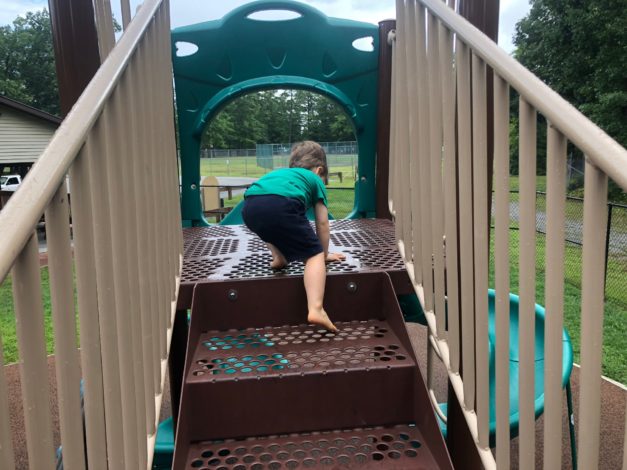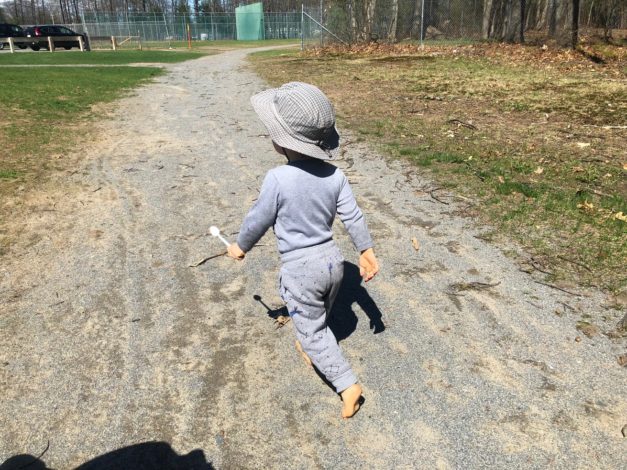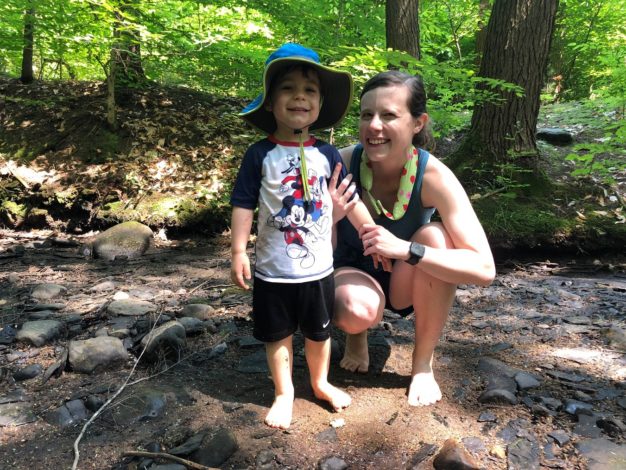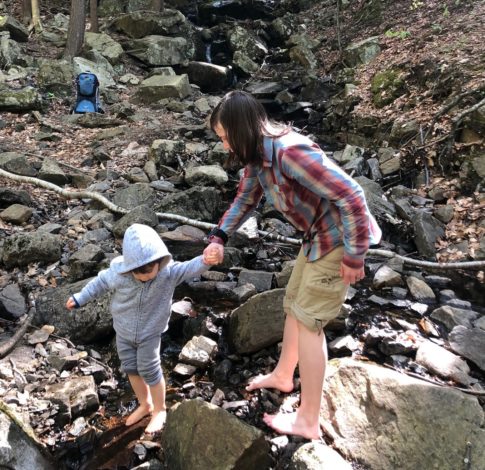Baring it all: The Benefits of Going Barefoot
- Blog Baring it all: The Benefits of Going Barefoot
One morning late last summer, I took my then-2-year-old to the nearby playground to run off some of his boundless energy. When we got there, he kept pointing to his heel and saying “Owie!” Upon inspection, he had a cut on his heel and his shoe kept rubbing the raw area with every step. I was generally a “we wear shoes when not in our house or yard” kind of parent, but since we were already there, I removed his shoes and off he went. As I watched, my normally clumsy toddler was gracefully ascending ladders and hurrying up the ramps and steps with ease. He was giggling like a maniac and tried things he normally wouldn’t.
 What could have changed in the 24 hours since we had been there last? That’s when it hit me: he wasn’t wearing shoes. He usually slipped around with his shoes on since the equipment was still damp from morning dew. Without his shoes, he was able to grip better and “feel” where he was. After that day, I allowed (and encouraged) my son to go barefoot more often, and I did the same. That also got me wondering: Are there other benefits to going barefoot? And how can you do it safely?
What could have changed in the 24 hours since we had been there last? That’s when it hit me: he wasn’t wearing shoes. He usually slipped around with his shoes on since the equipment was still damp from morning dew. Without his shoes, he was able to grip better and “feel” where he was. After that day, I allowed (and encouraged) my son to go barefoot more often, and I did the same. That also got me wondering: Are there other benefits to going barefoot? And how can you do it safely?
 4. Going barefoot can have a “grounding” effect on the body: Though it may sound like a myth, studies have shown that direct contact with the negatively charged earth can balance out the positive charges that build up in our bodies over time. The rubber soles of our shoes prevent this balancing, and the positive charges can continue to increase, which can lead to a myriad of health problems. Emerging research is suggesting that “grounding” or “earthing” may be beneficial in lowering stress, decreasing chronic pain, increasing energy, speeding up healing, etc.
5. It’s fun and delightful for the senses: This is likely the most important point on this list to our little ones, but this can be especially beneficial to young children who are just starting to experience the world around them. Feeling the difference between wet grass, squishy mud, cool sand and rough gravel can teach them about differing textures. It can also be an enlightening experience for their parents, who may not have felt these differing sensations in a long while due to continual shoe-wearing!
4. Going barefoot can have a “grounding” effect on the body: Though it may sound like a myth, studies have shown that direct contact with the negatively charged earth can balance out the positive charges that build up in our bodies over time. The rubber soles of our shoes prevent this balancing, and the positive charges can continue to increase, which can lead to a myriad of health problems. Emerging research is suggesting that “grounding” or “earthing” may be beneficial in lowering stress, decreasing chronic pain, increasing energy, speeding up healing, etc.
5. It’s fun and delightful for the senses: This is likely the most important point on this list to our little ones, but this can be especially beneficial to young children who are just starting to experience the world around them. Feeling the difference between wet grass, squishy mud, cool sand and rough gravel can teach them about differing textures. It can also be an enlightening experience for their parents, who may not have felt these differing sensations in a long while due to continual shoe-wearing!


 What could have changed in the 24 hours since we had been there last? That’s when it hit me: he wasn’t wearing shoes. He usually slipped around with his shoes on since the equipment was still damp from morning dew. Without his shoes, he was able to grip better and “feel” where he was. After that day, I allowed (and encouraged) my son to go barefoot more often, and I did the same. That also got me wondering: Are there other benefits to going barefoot? And how can you do it safely?
What could have changed in the 24 hours since we had been there last? That’s when it hit me: he wasn’t wearing shoes. He usually slipped around with his shoes on since the equipment was still damp from morning dew. Without his shoes, he was able to grip better and “feel” where he was. After that day, I allowed (and encouraged) my son to go barefoot more often, and I did the same. That also got me wondering: Are there other benefits to going barefoot? And how can you do it safely?
The Benefits of Letting Kids (and Adults) go Barefoot
1. It aides in proper foot development: If a child’s feet are constantly confined (especially in poorly-constructed shoes), they are unable to develop properly. This can cause permanent changes in the structure of the foot and alter the natural gait (or how we walk). As a result, it can create health issues like knee, hip and back problems in extreme cases. 2. It helps strengthen the feet, ankles and lower legs: Greater strength leads to greater agility and less injury. While shoes are great at offering extra stability, this actually interferes with the natural development of ankle and foot stability. 3. It helps a child develop body awareness (also called proprioception): Since our feet carry hundreds of thousands of nerve endings, they are very sensitive. Therefore, being barefoot actually makes us safer and more aware of our surroundings. For example, when my son wears shoes, he can’t feel the differences in ground covering as well. Since he likes to run, this can be an issue as he runs the same on grass or on concrete; but running fast on concrete almost always ends in a fall and some badly scraped knees for him. In contrast, when he runs barefoot, he naturally slows down when the surface turns hard (such as concrete or gravel). This helps prevent a bad fall and injury. In addition, being barefoot allows a child to grip, pivot, balance, etc., since they can feel the shift in the ground below them. 4. Going barefoot can have a “grounding” effect on the body: Though it may sound like a myth, studies have shown that direct contact with the negatively charged earth can balance out the positive charges that build up in our bodies over time. The rubber soles of our shoes prevent this balancing, and the positive charges can continue to increase, which can lead to a myriad of health problems. Emerging research is suggesting that “grounding” or “earthing” may be beneficial in lowering stress, decreasing chronic pain, increasing energy, speeding up healing, etc.
5. It’s fun and delightful for the senses: This is likely the most important point on this list to our little ones, but this can be especially beneficial to young children who are just starting to experience the world around them. Feeling the difference between wet grass, squishy mud, cool sand and rough gravel can teach them about differing textures. It can also be an enlightening experience for their parents, who may not have felt these differing sensations in a long while due to continual shoe-wearing!
4. Going barefoot can have a “grounding” effect on the body: Though it may sound like a myth, studies have shown that direct contact with the negatively charged earth can balance out the positive charges that build up in our bodies over time. The rubber soles of our shoes prevent this balancing, and the positive charges can continue to increase, which can lead to a myriad of health problems. Emerging research is suggesting that “grounding” or “earthing” may be beneficial in lowering stress, decreasing chronic pain, increasing energy, speeding up healing, etc.
5. It’s fun and delightful for the senses: This is likely the most important point on this list to our little ones, but this can be especially beneficial to young children who are just starting to experience the world around them. Feeling the difference between wet grass, squishy mud, cool sand and rough gravel can teach them about differing textures. It can also be an enlightening experience for their parents, who may not have felt these differing sensations in a long while due to continual shoe-wearing!

How to go Barefoot Safely
The most common question I get when others see my son and me playing or hiking barefoot is, “Isn’t that dangerous? What if there is glass or nails or (fill in the blank with other dangerous objects) on the ground?” Surprisingly, playing and hiking barefoot is quite safe and enjoyable, especially after some practice. My son has gotten more injuries tripping over his clunky hiking boots than when he's barefoot. Here are a few tips for going barefoot safely to ease both the discomfort of your feet and your mind: 1. Start slow: Little kids tend to adapt quickly to being barefoot, but adults who have worn shoes extensively for most of their life will need to “train” their feet to go barefoot. I made the mistake of starting my “barefoot habit” by going on a one-mile hike barefoot. Since my feet, ankles and calf muscles weren’t used to it, they all ended up very sore and the soles of my feet were screaming at me! I realized that jumping right in without practice was probably not the best choice. To start slow, you can try running around your yard or walking to the mailbox without shoes. You can also allow your kids to kick off their shoes when playing at the playground or running around outside. Over time, the soles of the feet will start to toughen and you can go barefoot for longer periods of time on more variable terrain. 2. Choose familiar places: Whether it be a playground you visit frequently or a favorite trail you hike often, choosing a familiar area that you know has safe terrain can help put your mind at ease. By “safe terrain,” I am referring to areas that are generally free from glass and other “unnatural” materials. For example, there are a few trails we enjoy walking, but due to their proximity to a concert hall, I won’t allow my little dude to go barefoot due to the debris that is frequently left over from concert-goers. However, we frequently walk to and play at the neighborhood playground in our bare feet. 3. Have a backup plan: I feel like, as parents, our lives are constantly filled with backup plans. And backup plans for our backup plans. Barefoot hiking and playing is no different. I always bring shoes for both my little dude and myself when we go barefoot. That way if the ground is hot or there's glass or dangerous debris, we don’t have to end our fun.
When shoes are necessary: what to look for
While being barefoot is wonderful and has various benefits, sometimes shoes are a necessity, whether due to outside temperature or an unsuitable environment. The keys to a good pair of shoes for kids (and adults too) are flexibility, breathability and natural shape. Shoes that are too structured and rigid can inhibit natural foot growth. Check out this article for more information on what to look for in shoes for young children. It is important to note that children’s feet are constantly growing and even changing shape. It's a good idea to get sized for both foot length and width (since many children actually have wide feet). Even as adults, our feet can change (anyone else go up a size after pregnancy?), so we should also get sized. In addition, walking around in shoes before buying them and not settling for a “mostly comfortable” pair is important since everyone’s feet (and every shoe) are different. What are your thoughts on letting your kids (and yourself) go barefoot? Let us know in the comments below!Read more:
Photos by Rebecca Hosley. Feature photo by Laura Castro.Related Content




Comments